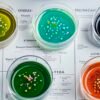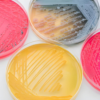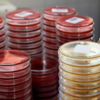.jpg)
Ready-to-use culture media (RTU)are pre-prepared, sterile, and convenient tools for microbiological testing in labs. These products are designed to save time and reduce the complexity of manual preparation, ensuring that labs can focus on their core tasks—testing, research, and diagnostics. In this article, we will explore the effective use of RTU culture media, from proper storage to correct application in various microbiological experiments.
1. Understanding Ready-to-Use Culture Media
Ready-to-use culture media come in various forms, each tailored to specific types of microorganism cultivation. Whether it’s for bacterial, fungal, or viral growth, these media provide a nutrient-rich environment for microorganisms to grow and thrive. Some common types of RTU culture media include:
- Nutrient Agar: A general-purpose medium for growing a variety of non-fibrous microorganisms.
- MacConkey Agar: Used for isolating gram-negative bacteria.
- Sabouraud Dextrose Agar: Specifically designed for fungal cultures.
- Chromogenic Media: Used for identifying specific bacteria based on color reactions.
2. Proper Storage and Handling of RTU Culture Media
To maintain the integrity and sterility of RTU culture media, proper storage is crucial. Here are key steps to follow:
- Store in a Cool, Dry Place: RTU media should be stored at the temperature recommended by the manufacturer (usually between 2–8°C). This prevents premature degradation of the nutrients.
- Avoid Direct Sunlight: UV radiation can degrade certain media components, so it’s important to keep the media in a dark storage space.
- Check Expiry Dates: Always ensure that the media is within its shelf life. Expired media may result in failed cultures or unreliable results.
- Seal Properly: Ensure that any opened media containers are resealed tightly and used promptly to avoid contamination.
3. Best Practices for Using Ready-to-Use Culture Media
While RTU media simplifies the lab process, there are specific guidelines to follow for optimal use:
- Inoculation: Sterilize all tools, such as inoculating loops or spreaders, before use. This ensures that no contaminants are introduced into the media.
- Avoid Over-Inoculation: Adding too many samples can affect the growth pattern of microorganisms. Follow the manufacturer’s guidelines for the optimal amount of inoculum.
- Incubation Conditions: Follow the media’s specific temperature and humidity recommendations for optimal microbial growth. Different organisms require specific incubation conditions.
- Proper Sealing: After inoculation, ensure that plates or containers are sealed correctly to prevent contamination and evaporation.
- Use Proper Disposal Methods: Once the media has been used, it should be disposed of in line with lab safety protocols, especially if it contains hazardous or infectious materials.
4. Troubleshooting Common Issues
While RTU media is designed for convenience, it’s important to know how to address potential problems that may arise during its use:
- No Growth or Poor Growth: This could be due to improper incubation, expired media, or incorrect sample inoculation. Double-check the conditions and ensure the media is still viable.
- Contamination: If contamination occurs, it’s likely due to improper handling, such as using non-sterile equipment or incorrect storage. Ensure strict aseptic techniques are followed.
- Unexpected Results: Variations in microbial growth patterns can sometimes be attributed to incorrect preparation or environmental factors. Always use fresh RTU media and ensure correct incubation.
5. Advantages of Using Ready-to-Use Culture Media
The primary benefit of using RTU culture media is the significant time saved in laboratory preparation. Other advantages include:
- Convenience: Pre-prepared and sterile media reduce the need for manual preparation, making your workflow more efficient.
- Consistency: Ready-to-use media come with consistent formulations, ensuring reliable and reproducible results.
- Safety: Sterility is guaranteed, which helps avoid contamination, making these media ideal for critical testing in clinical and research settings.
- Cost-Effective: While the initial purchase cost may be higher than DIY media preparation, the time saved and reduced risk of error make RTU media a cost-effective option in the long term.
6. Conclusion
Ready-to-use culture media are an essential part of modern microbiological testing, offering convenience, precision, and efficiency. By following proper storage, handling, and application procedures, labs can ensure the highest quality results in their microbial investigations. Incorporating these media into your daily practices will save time, reduce contamination risks, and improve the accuracy of your experiments.
Recent Posts
- A Guide to Using Culture Media for Strict European Cosmetic Safety Compliance
- The Role of Culture Media in Ensuring Accurate Cosmetic Microbial Testing
- Transport Media and Their Role in Microbial Sample Transport
- How Culture Media Impact the Precision of Cosmetic Microbial Testing
- Optimize Lab Efficiency with Granular Culture Media



